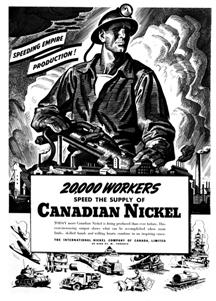Roger Whittle’s Amazing Invention – the Jet Engine
The successful development of British-born Roger Whittle’s amazing invention, the jet turbine engine was integrally linked to Inco’s metallurgical expertise with high temperature nickel alloys.
In the early 1940s, at the request of Britain’s Air Ministry, company scientists worked furiously to solve the problem of appropriate materials for emerging designs in jet and gas turbine engines. The Germans were also working on their own version of a jet engine the Messerschmitt Me 262.
One of the most noted contributions during the war was the invention of a new alloy for jet-propelled aircraft engines by International Nickel metallurgists from the Henry Wiggin & Company Ltd. facilities in Birmingham.
This new alloy called “Nimonic 80” allowed the jet engine’s turbine parts, particularly the blades, to operate for long periods under tremendous stress, high heat and corrosive exhaust without deforming or melting. This new alloy was superior to German aircraft technology. The first British airplane outfitted with the new engine was the Meteor which first flew in 1943 and was finally approved for the air force in July, 1944.


























